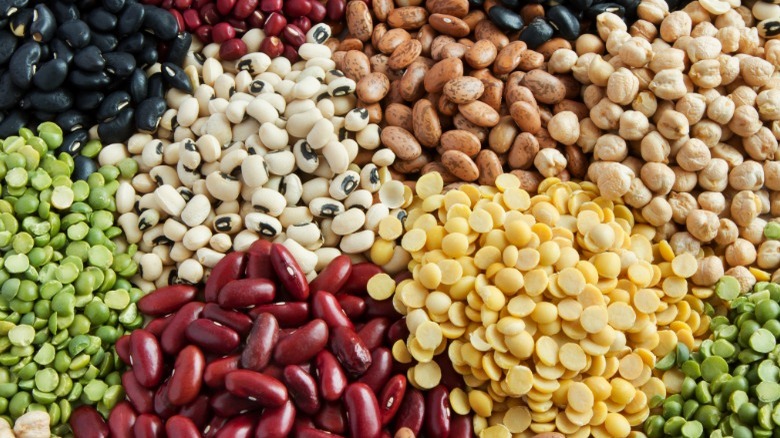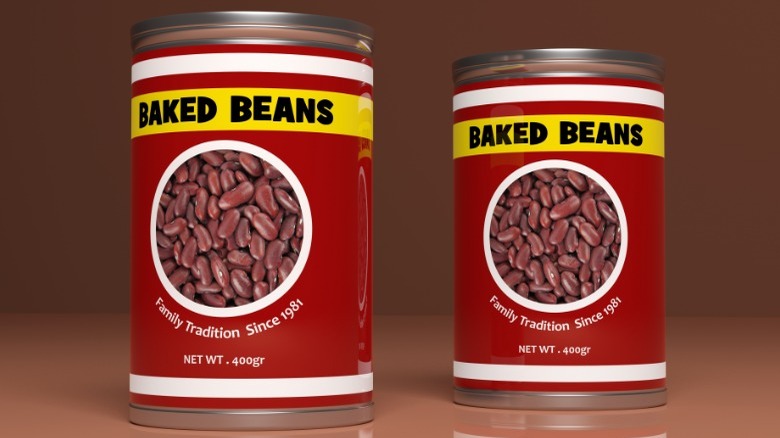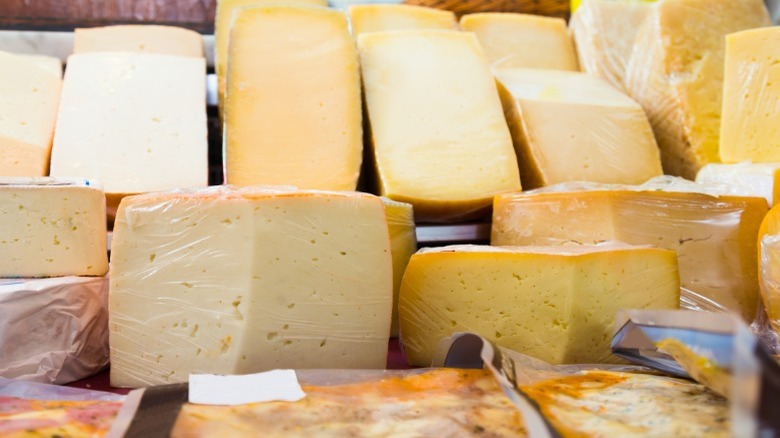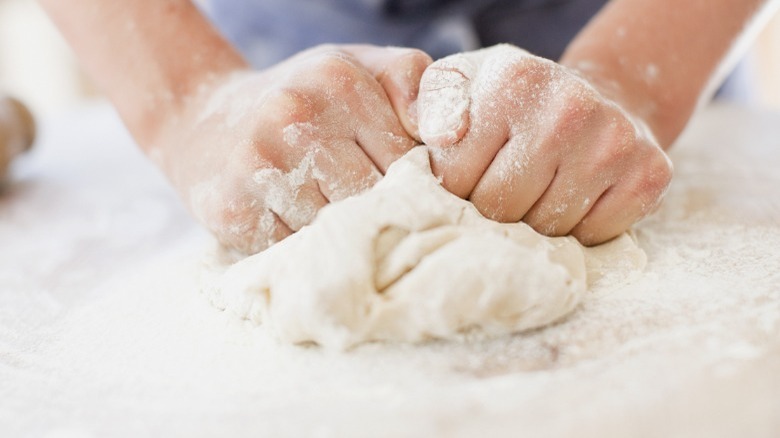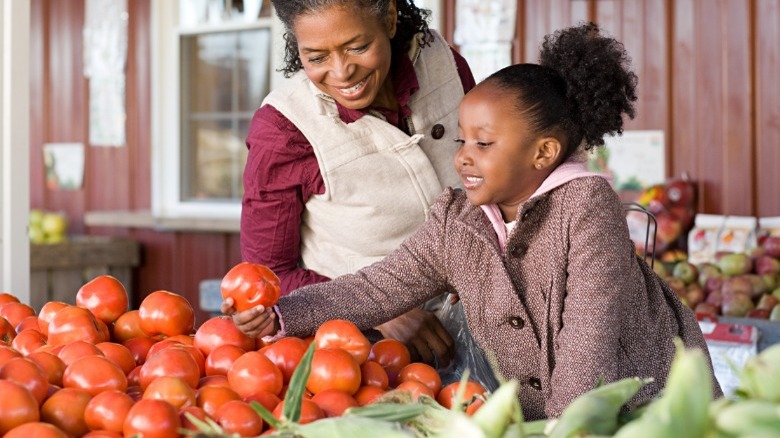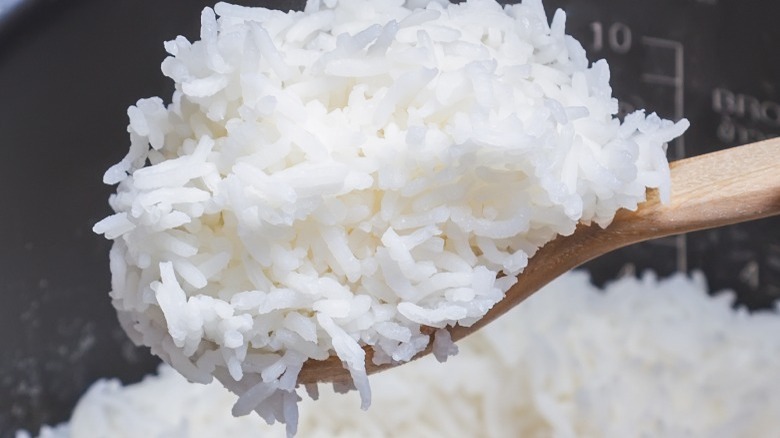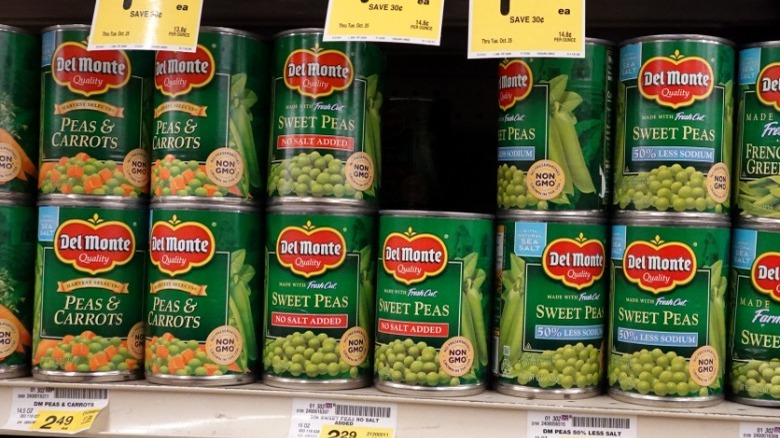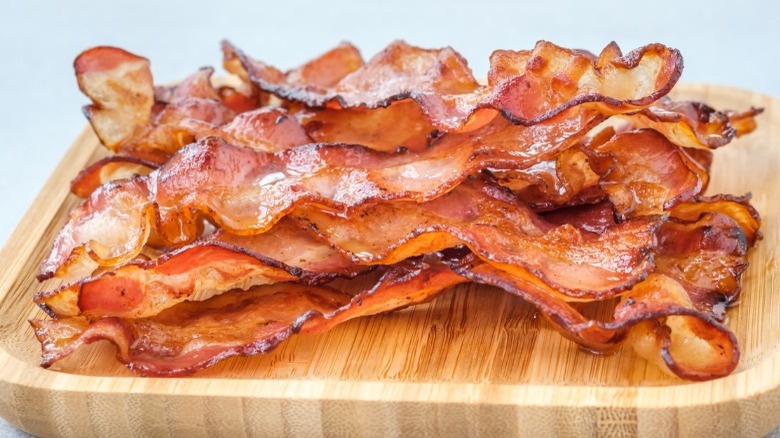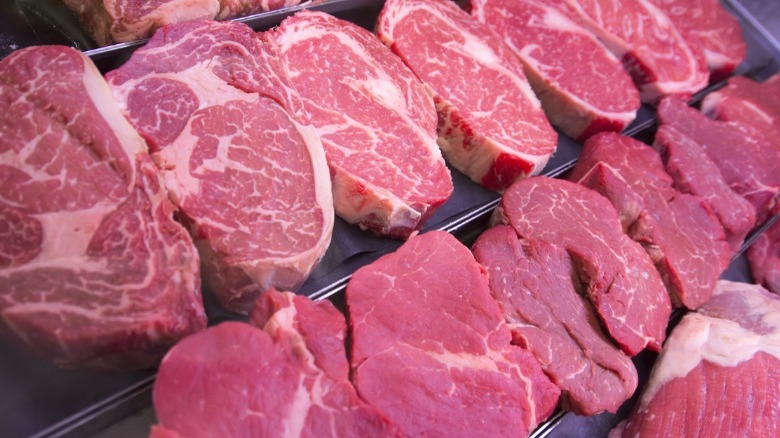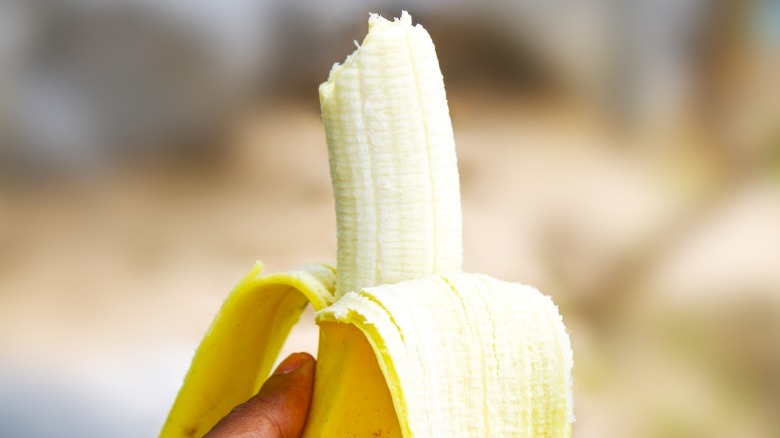12 Inflation-Resistant Foods You Should Be Stocking Up On In 2023
We may receive a commission on purchases made from links.
Remember when you used to see so many smiling faces in grocery stores? Thanks to inflation, it's rare to see happy shoppers browsing the produce and meat aisles these days. Food prices constantly fluctuate because of supply and demand, but over the past few years, some have increased exponentially while others remain more affordable. With market conditions constantly changing, who knows what the future holds? One way to combat these crazy prices is to stock up on staples that won't break the bank.
Time recently reported on price increases for certain foods that have not proved to be inflation-resistant, and the data is sobering. Eggs had the highest price jump in a one-year period from $1.79 a dozen to $4.25, but that also reflects supply chain issues from the avian flu outbreak. Butter rose from $3.47 to $4.25 a pound during this same time. Other staples hit hard by inflation include potato chips, milk, and ground beef. Anyone who shops for food has also seen much higher prices for cereal, oils, and bread.
Avian flu also drove up the price of chicken, but now that the issue is under control, egg and chicken prices might level out. These wildly fluctuating prices can give anyone a headache and make it hard to plan reasonably-priced meals. Fortunately, some foods are more resistant to inflation, and you can stock up on them. In many cases, they can be frozen. Use the extra money to buy a second freezer, and you'll be ready when prices shoot up again.
1. Dry beans
Beans are packed with nutrition and sold in two forms on grocery shelves — dried in bags and cooked in cans. They are a rich source of fiber, which fills up the belly. A half-cup serving averages seven grams. Beans are also high in protein and folate and are incredibly versatile. Dry beans are the cheaper choice because they are not processed like canned ones. You have to rinse, soak, and cook them instead of popping open a can and pouring them into a pot.
Dry beans are not a hugely popular item at grocery stores because of the long preparation times, and consequently, they are not a highly valuable commodity. YCHARTS shows that the stock market value for U.S. Beans, Dry Edible dropped from 51.50 on May 31, 2022, to 39.60 on January 31, 2023. Those numbers represent hundredweights, a measurement used with commodities. In layperson's terms, one hundredweight equals 100 pounds. The price of dried beans decreased by 8.33 percent during this period.
These are the perfect food to stock up on because the shelf life is longer than most other non-perishable foods. They easily last up to a year in cool, dry places like pantries. Dried beans can last even longer, though the nutritional value will be gone in about five years.
2. Canned beans
Baked beans and their canned cousins can be found in countless kitchens and are camping trip go-tos. They cost more than dried beans, but when inflation is at its worst, you'll see grocery carts packed with them. However, according to The Bean Institute, a half cup of canned beans can have an average of 200 grams of sodium, and the FDA advises adults to limit the intake to less than 2,300 mg. You can reduce that amount by up to 40 percent by rinsing the beans under cold water. You probably won't notice the difference.
The price of canned beans has risen, but it's still possible to grab cans for less than a buck apiece. Don't Waste the Crumbs claims that a 15.25-ounce can of Walmart Great Value black beans cost $0.63 in 2020, which was an undeniable bargain. In March of 2023, we found them for $0.78 on the website. That's almost a 24 percent increase, but since the pre-inflation price was that low, people won't complain too much about paying another 15 cents. And as long as the cans aren't rusted, dented, or otherwise damaged, they're shelf-stable and will be edible for years.
3. Potatoes
Fresh raw potatoes can last for a few months before going bad but often jump the shark much sooner than that. Still, they are relatively inflation-resistant, so you can stock up, cook them, and put them in the freezer. Potatoes are a healthy choice (unless they're drowned in oil or butter) because one 5.3-ounce serving contains 2 grams of fiber, only 1 gram of sugar, no fat, and high amounts of vitamin C and potassium (via Potatoes USA).
Yahoo! Finance claims that the price of potatoes increased by 3.4 percent from 2021 to 2022, and like beans, the cost before the recent inflation was low to begin with. Federal Reserve Bank of St. Louis tracks the average per-pound price of white potatoes and confirms a moderate price increase of 1.000 in October of 2022 to 1.026 in February 2023. In February 2020, it was at 0.808. The prices of frozen French fries and hash browns still haven't come down that much, so in the meantime, buy fresh potatoes in bulk and make your own. They're healthier for you, anyway.
4. Cheese
The words freeze and cheese rhyme and are further compatible because you can do the first to the second. We're not talking about gourmet cheeses like Brie, Gruyere, and Stilton. Prices for luxury items aren't inflation-resistant. Trading Economics posts that the price of cheese has decreased in 2023, dropping by 1.02 percent. It was at a high point of 2.58 per pound in July 2020 and decreased to 2.4 by May 2022. On March 27, 2023, the per-pound price was 2.039.
Cheese Reporter shows how the average price of a 40-pound block of cheddar has changed over time. You needn't rush out to buy one unless you own a restaurant or have to feed 100 people, but this serves as a good reference since the savings get passed down to consumers. It was 2.71 in October 2020 and 1.889 in February 2023. Fortunately, cheddar freezes well, and so do other firm cheeses like Monterey Jack and Parmesan. You can freeze blocks, pieces, and bags of shredded cheese for up to three months, but if you take them out of the packaging, seal them in freezer bags and press out all the air before closing.
5. White flour
White flour is another versatile pantry staple that's weathered inflation well. The price has fluctuated greatly over the years, but you can usually grab a 5-pound bag for around $5 or less these days. CEIC Data shows that the U.S. price for a pound of flour was $0.46 in December of 2017, and during that same year, the inflation rate was 2.1 percent, according to the balance. The inflation rate was at 6.5 percent in 2022, and the balance estimates it to drop back down to 2.7 percent in 2023.
A chart from the Federal Reserve Bank of St. Louis has the price of flour at 0.455 in April 2022 and 0.55 in February 2023. It looks like the price of flour is pretty resistant to inflation, so feel free to grab a few large bags. It won't last for more than three months in the original packaging , so be sure to have large, airtight containers on hand. Fill them up and tightly secure the lids. Your flour should be good for up to two years. Write the date on a piece of masking tape and stick it on as a reminder.
6. Tomatoes
Technically a fruit, ripe tomatoes add savory zest to salads, sides, and entrees, and plenty of people love snacking on them. These have been inflation-friendly, with consumer prices staying reasonably consistent. A USDA Economic Research Service chart shows that the consumer per-pound price of tomatoes ranged from about $1.50 a pound to just under $2.00 a pound from 2007 to 2021 — not a huge change.
The U.S. Bureau of Labor Statistics shares an interesting arc for fresh tomato prices from 2003 to 2023. Twenty years ago, field-grown tomatoes averaged $1.57 a pound, but this spiked in 2005 and 2017. Since inflation wasn't at unusually high levels in those years, the increases could have been caused by growing conditions and other factors. The March 2021 price was $1.77, and December 2022 was $2.23. The latest data for February 2023 shows $1.99. There's no question that tomato prices go up and down and that designer tomatoes cost more, but the prices are more prone to change because of supply conditions like weather and acreage. So enjoy those fresh tomatoes while you can, cook the extra ones into your favorite recipes, and freeze the leftovers.
7. Rice
More than 100 countries on Earth consider rice a staple food, and it comes in different colors, sizes, and flavors. It is a major source of carbohydrates, and brown rice is known to be high in fiber, B vitamins, and other nutrients. And fortunately, it's one of the least expensive grains you can buy, especially when you go with a store brand. For example, you can get a 2-pound bag of Kroger long-grain brown rice for $1.59, and that'll be good for at least a few meals.
According to the U.S. Bureau of Labor Statistics, the price of white long-grain rice was $0.83 per pound in February 2022 and $0.959 in February 2023. Trading Economics adds that average prices dropped by 2.77 percent since the start of 2023. Consumers also see changing rice prices for reasons other than inflation. India and China are two of the world's largest producers, and if either cuts back on production, the prices go up. Historically, it has remained pretty affordable, particularly the store brands. Store rice the same way as flour, and it'll last longer, but toss it when it starts to smell funny, look greasy, or has bugs in it. Ew.
8. Canned veggies
Canned vegetables can be just as healthy as fresh or frozen, even if they aren't as flavorful and contain more salt. Canned corn, green beans, and peas are consistently low-priced and haven't gone up enough to make people stop buying them during inflation.
Looking at canned green beans, a USDA Economic Research Service report shows that these vegetables were priced at $0.82 a pound in 2016. That same year, green peas were $0.99, and corn was $0.85. Fast-forward to 2023. ShopRite has its Bowl & Basket brand version at less than $1 for 14.5 ounces and Green Giant for $1.49. Did the can sizes use to be larger? Yes, but this is nothing new. Over the past decade, canned vegetable sizes have dropped from 16 ounces to as low as 13. You'll also see smaller pasta boxes, cereal boxes, and ice cream containers. Still, the smaller-sized canned vegetables are enough for two or three people and remain cheap. Peas and corn were about the same price as those beans, and shelf-stable foods like these last so long they might even outlive you.
9. Strawberries
Strawberry prices also reflect market conditions other than inflation. This held true in 2022 when inflation was soaring. The average grocery store price for a pint was $2.31 in June of that year and dropped to $2.20 the next month. Weather conditions impacted prices. Heavy rains in California reduced West Coast supplies, but perfect spring weather on the East Coast helped.
Federal Reserve Bank of St. Louis shows that the average price of strawberries has steadily climbed since 1985, going up and down. The pattern didn't change significantly during past periods of inflation (and recession), so supply is the likelier culprit. Berries can't be grown year-round in much of the U.S., so prices also spike when it's too cold to grow them outdoors. Here are some dates and numbers: In July 2020, during the height of the pandemic, strawberries were at $2.02 a pound. The following November, they jumped to $2.93. By December 2022, strawberry prices crept up to $3.85. Now, they're trending lower again. So when the weather is right, you'll see nicer prices, and that's the time to stock up on this sweetly tangy fruit.
10. Bacon
Here is some truly exciting news. The average price of bacon dropped from 2022 to 2023, as have prices for some other pork products. This is because drought conditions in the Western U.S. forced many farmers to cull (slaughter) their herds to reduce overhead costs. Will the prices go back up? It's possible, but it depends on other factors.
For the time being, consumers can enjoy a temporary break, but there are no guarantees for the future. Bacon prices rose with inflation but started declining after July 2022. Beef2Live puts it in perspective by sharing the prices from 2016 to 2023. In January 2016, the retail price for a pound of bacon was $5.66. By December 2019, it was $5.47. By June 2021, consumers were paying $6.67 a pound, and the price topped off at $7.61 in October 2022. The February 2023 average price has inched down to $6.60. This is another prime example of how other factors influence food prices, so hurry up, get those eggs ready, and have at it.
11. Steak
As with almost all other foods in grocery stores, steak hasn't returned to pre-pandemic prices yet. However, buying beef steak is slightly less painful because the costs have dropped by about 3 percent this past year. Those drought conditions have had the same effect on farmers, and consumers have gotten a little break for now. And that's not all. Consumer demand for high-end cuts has weakened, and there are reports that processing plant staffing shortages have eased.
Don't get too excited because finding filet mignon for $3.99 a pound is the stuff of fantasies. Prices like that are a thing of the past. However, the U.S. Bureau of Labor Statistics points out that the price of uncooked beef steak went down by 1.9 percent from February 2022 to February 2023. This is interesting when you compare it to ground beef, which went up by 0.3 percent. And what about chicken? The average price jumped by 8.8 percent during that time.
This doesn't mean that it's a good idea to start eating meat five times a week, though. Meat that's high in saturated fat can increase cholesterol and increase the chances of heart disease. Opt for leaner cuts like sirloin and filet mignon, and limit your intake to once or twice a week.
12. Bananas
Bananas tend to be inflation-resistant because they can be grown around the world, and this means that consumers enjoy a consistent supply. Production grew 3.2 percent yearly from 2000 to 2017, and the price has only increased slightly during the past 15 to 20 years. Few people dislike bananas, and they're fun to eat. They're also more versatile than other fruits like oranges. Consumers bake bananas into bread, cakes, and muffins. They are also very smoothie-friendly.
CTV News shows that in Canada, the price of bananas increased by 6.3 percent from July 2017 to July 2022. Grapes also went up by 20.9 percent, pears by 28.5 percent, and apples by 36 percent during those five years. Bananas and other fruits can cost more in farther-north countries and must be imported from faraway places like Latin America. The U.S. gets bananas from there too, but also from Florida. A USDA Economic Research Service chart shows that the per-pound price of bananas was $0.57 in 2020 and rose incrementally each year. It's now about $0.64. That's still pretty cheap. For example, you can buy a small bunch (four to six bananas) at Baltimore's Giant Foods for $1.52. And as with other fresh produce, you'll always pay more for organic. Those bananas come in at $2.18 a pound.

